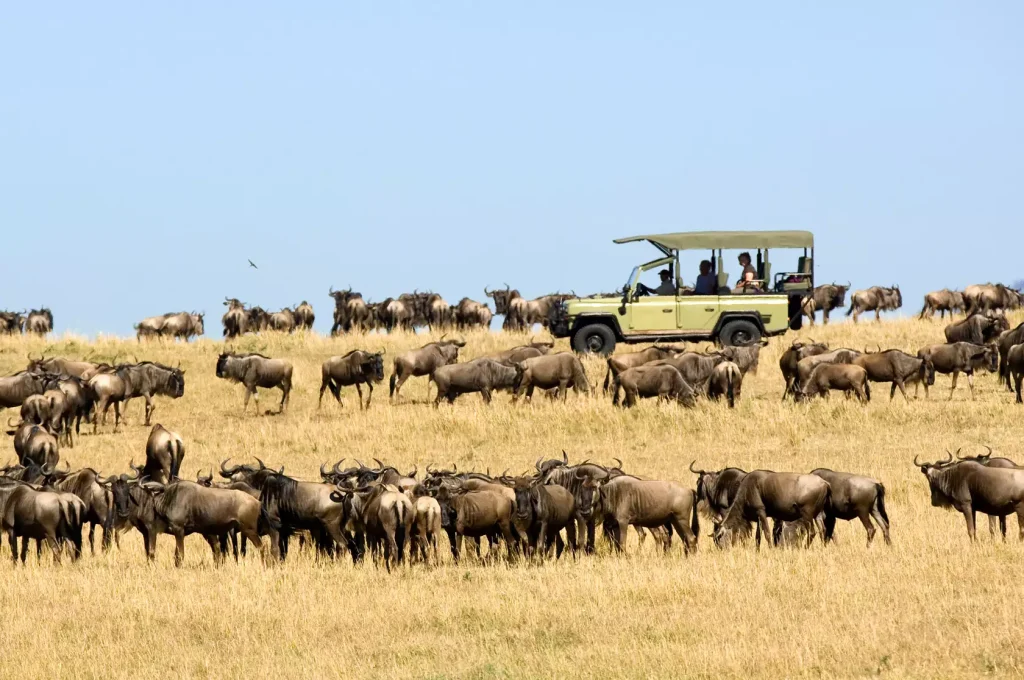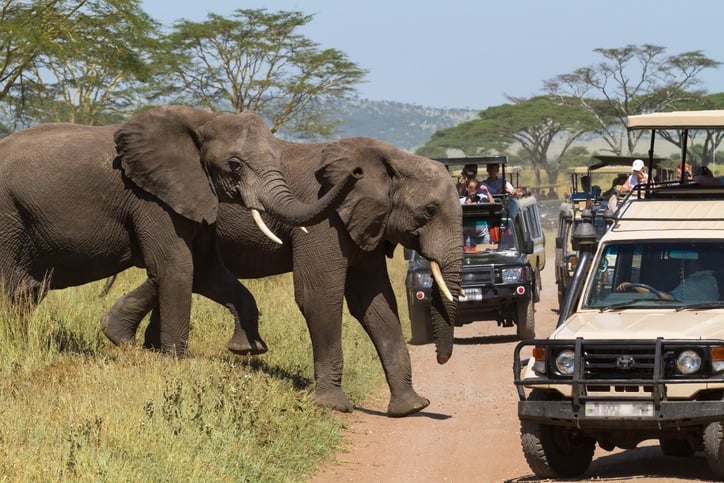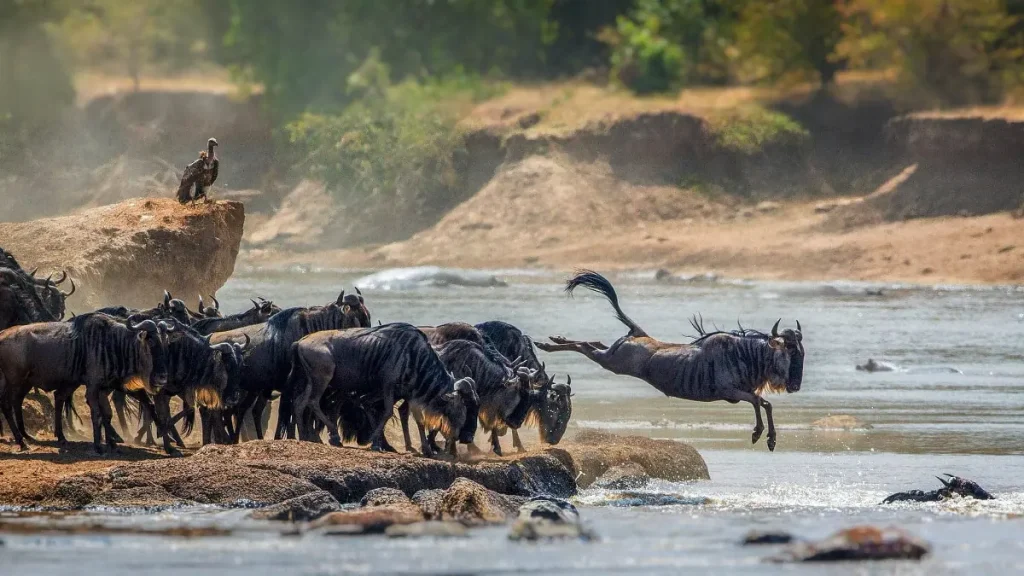The Great Migration in Serengeti National Park
The Great Migration in Tanzania’s Serengeti National Park is one of the most awe-inspiring wildlife spectacles on Earth, making the park one of Africa’s top safari destinations to visit. The Great Migration is a pulsating, year-round movement of over two million wildebeest, zebras, and gazelles across the Serengeti–Mara ecosystem. This epic journey follows a nearly 800-kilometer circular route, dictated by seasonal rainfall patterns and the ever-shifting growth of fresh grasses.
Spanning from the southern Serengeti plains to Kenya’s Masai Mara, this clockwise journey offers travelers a front-row seat to the raw beauty and mystery of nature. The Great Migration is the heartbeat of the African wilderness, and witnessing it is truly breathtaking. The spectacle begins in the southern Serengeti plains, where half a million wildebeest calves are born between January and March. The area is lush, predator-filled, and alive with the urgency of new life. As the plains begin to dry, the herds then move north and west in search of more nutrient-rich grazing lands, facing predator ambushes, and dangerous river crossings amidst the merciless rhythm of nature.
The Great Migration isn’t just a movement of wild animals; it is a year-round cycle of birth, survival, and regeneration of nature itself: a once-in-a-lifetime event for those fortunate enough to witness it.

What is the Great Migration in Serengeti National Park Like?
The Great Migration in Serengeti National Park is the largest land-based mammal migration on Earth, with up to 1,000 animals per square kilometer. The migration features sprawling herds of wildebeest that create a spectacle so vast that their dusty trails and dark columns have been said to be visible from space. Over 1.2 million wildebeest, joined by 300,000 zebras, and hundreds of thousands of gazelles (Thomson’s and Grant’s gazelles), along with topi, move in a cyclical, seasonal loop in search of water and fresh, nutrient-rich grasses.
Guided by instinct sharpened over millennia, each wildebeest travels between 800 and 1,000 kilometers per year, tracing ancient migratory corridors carved by survival and time. However, this is no gentle pilgrimage! It is a high-stakes struggle, shadowed at every step by Africa’s most formidable predators, including lions, leopards, cheetahs, hyenas, wild dogs, and massive Nile crocodiles.
The movement begins in the Ngorongoro Conservation Area in southern Serengeti, winds through the heart of the national park, and crosses into Kenya’s Masai Mara, before looping back again. Along the way, the herds must brave swollen rivers, treacherous terrain, and hungry predators. Young calves are vulnerable; the injured and exhausted fall behind, while many perish in dramatic river crossings or beneath the claws of prowling predators.
Interestingly, the Great Migration also features a delicate yet fascinating ecological sequence. Each of the vast grazing species has a distinct feeding habit; for instance, zebras graze on the tall, coarse blades of grass, while wildebeest consume the middle layers, and the gazelles finish the job by feeding on the shorter shoots. This tiered grazing pattern reduces competition and ensures a self–sustainable landscape.

The Great Migration in Serengeti National Park is known as “the greatest show on Earth,” featuring a high-stakes drama of survival displayed on the open stage of the savannah. Despite its massive scale, the migration is in no way a guided expedition; the herds instead appear to respond to natural cues, primarily rainfall and the emergence of fresh grasses. Though unproven, many experts believe that wildebeest are capable of sensing distant storms and may detect rainfall from over 50 kilometers away, possibly through changes in atmospheric pressure, or even low-frequency sounds associated with thunder. Nonetheless, their clear destination is one – survival.
Seasonal Movement of The Great Migration
Planning a Serengeti safari to explore the Great Migration is crucial for any traveler. While the cycle is generally predictable, factors like rainfall patterns and climate variations may influence the timing each year. Below is a breakdown of the migration’s seasonal rhythm to help increase your odds of witnessing this spectacular wildlife spectacle.
The Great Migration between January – March: Calving Season in the Southern Serengeti
Every year from January, the endless plains of southern Serengeti and the Ngorongoro Conservation Area erupt with life. Around January, the migrating herds complete their southward journey to the fertile grasslands around Ndutu and the Olduvai Gorge. Here, nutrient-rich grasses flushed by the recent short rains create the perfect nursery for the herds to give birth to their calves. Late January to March marks the calving season, which is unofficially known as the beginning of the migration cycle.
Within just a few weeks, nearly 400,000 calves are born, over 8,000 births per day. However, this explosion of life does not go unnoticed as predators, especially lions, hyenas, cheetahs, and leopards, move in quickly, targeting the vulnerable newborns. For those seeking raw, unscripted wildlife drama, this is the season of life and death during the Great Migration.
The Great Migration between April – May: The “Rut” Season
By April, the herds begin their northwestern ascent, moving away from the dry southern plains into the greener expanses of the central Serengeti. As the grasses thin in the south, fresh pastures beckon near the Moru Kopjes where lions lounge and leopards lurk. Travelers staying at Dunia Camp have the best chances of viewing the herds during this time of the year.
On the other hand, May brings the mating season, known as “the rut.” During this time, bull wildebeest compete in head-butting duels, establishing dominance as the herds stretch into long, dusty columns. Many zebras and gazelles move with them, maintaining their layered grazing patterns.
By the end of May, the migration swells again in the Western Corridor, where the herds prepare to cross the Grumeti River, a predator-laden passage patrolled by giant crocodiles. Though not as famous as the Mara crossings, the Grumeti spectacle is visceral and intimate, often seen with fewer crowds. Best camps to witness the migration during this time of the year include Ubuntu Migration Camp and Grumeti Reserve, among others.
The Great Migration between June – July: Grumeti River Crossings and Proceed to the Mara
As June ushers in the dry season across the Serengeti, massive herds of wildebeest begin to gather in the Western Corridor, particularly near the southern banks of the Grumeti River. This marks the beginning of the migration’s perilous river crossings, where each animal must bravely cross the Grumeti River, where enormous Nile crocodiles lie in ambush beneath the surface. Moreover, this is the first of several deadly obstacles the migration must overcome.
By early July, the momentum builds. The herds, now joined by hundreds of thousands of zebras and gazelles, push steadily north along the western edge of Serengeti National Park, heading toward the Mara River. Situated in northern Serengeti, the Mara River is infamous for its powerful currents, steep banks, and equally dangerous crocodile population. The Mara River crossing is considered among the most thrilling wildlife spectacles on African safaris, often featuring desperate leaps, chaotic splashes, and tense predator-prey standoffs.
The first Mara River crossings typically begin in July, which coincides with the start of high safari season, though the exact timing depends entirely on rainfall patterns and grazing conditions. By mid- to late July, successful crossers begin to appear in Kenya’s Masai Mara, while others linger in the northern Serengeti.
For front-row access to the drama, travelers can stay at Asilia Mobile Migration Camp or Sayari Camp, both ideally situated near key crossing points. While in Masai Mara, Kenya, camps like Mara Plains and Governor’s Camp also offer fantastic viewings of the river crossings.
The Great Migration between August – October: Mara River Crossings and Masai Mara Showdown
By August, the wildebeest have successfully crossed into the Masai Mara, while some remain in the northern Serengeti, creating dramatic scenes across both regions. The Mara River crossings, which are arguably the most iconic moments of the Great Migration, are often in full swing. When the river is deep and fast-flowing, confusion, panic, and predator ambushes lead to heavy losses as crocodiles, lions, and other predators take full advantage of the chaos.
As September rolls in, the frenzy begins to ease. The herds start to disperse across the Mara and slowly move eastward, continuing to graze and regroup. By October, many prepare to re-cross the Mara River, beginning their journey southward as the short rains approach. Though the peak drama has passed, this period still offers superb wildlife viewing, especially with fewer crowds in the reserves.
The Great Migration between November – December: Southbound Return Through Eastern Serengeti
As the short rains of November fall across the Serengeti, the herds begin their southbound return to the Serengeti. By now, the grasses of Namiri Plains and the eastern Serengeti are lush again, offering sustenance after months of travel. Meanwhile, numerous cheetahs in these open plains shadow the herds, adding one last chapter of predator-prey drama. Namiri Plains is especially prized this time of year for its big cat sightings, serenity, and sweeping vistas.
By December, the wildebeest are fanned across the southern reaches of the Serengeti, and the ecosystem breathes again, refueled and rebalanced. As the year closes, nature quietly prepares for another burst of life, and the Great Migration continues without pause.

When is the Best Time to Witness the Great Migration in Serengeti National Park?
Serengeti National Park is a year-round safari destination, rich in biodiversity and visual wildlife drama at every turn. However, timing your visit to intersect with the Great Migration can elevate your journey from wonderful to once-in-a-lifetime. Here’s a general guide for the best time to witness the Great Migration in Serengeti National Park;
Time of the Year |
Migration Phase |
Location of the Herds |
| January – March | Calving season | Southern Serengeti (Ndutu, Olduvai) |
| April – May | Early movement & Breeding | Central Serengeti & Western |
| June – July | Grumeti River Crossings | Western corridor, Grumeti River |
| August – October | Mara River Crossings | Northern Serengeti, Masai Mara |
| November – December | Return begins through the eastern Serengeti | Namiri Plains, Eastern Serengeti |
However, it is important to keep in mind that seeing the herds does not always guarantee witnessing dramatic river crossings. But with thoughtful planning and local guidance, your odds improve significantly.

